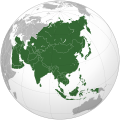The Americas, also known as America, [1] are lands of the Western Hemisphere, composed of numerous entities and regions variably defined by geography, politics, and culture.
Contents
- Physical geography
- Human geography
- Geographical or geopolitical regions
- United Nations geoscheme
- Political divisions
- Linguistic/cultural regions
- See also
- References
- Sources
The Americas are recognized in the English-speaking world to include two separate continents: North America and South America. In parts of Europe and Latin America, America is considered to be a single continent, within which North and South America are regions. [2]



















